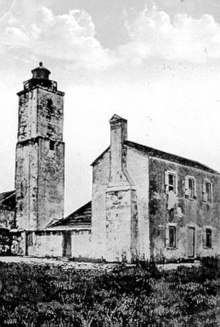Anastasia Island
From Wikipedia, the free encyclopedia
This article is about the island off the coast of Florida. For island in the Black Sea, see St. Anastasia Island.
Anastasia Island is a barrier island located off the northeast Atlantic coast of Florida in the United States. It sits east of St. Augustine, running north-south in a slightly southeastern direction to Matanzas Inlet. The island is about 14 miles (23 km) long[1][2] and an average of 1 mile in width. It is separated from the mainland by the Matanzas River, part of the Intracoastal waterway. Matanzas Bay, the body of water between the island and downtown St. Augustine, opens into St. Augustine Inlet.
Part of the island (the Davis Shores and Lighthouse Park neighborhoods) is within St. Augustine city limits, while other communities on the island include St. Augustine Beach,Coquina Gables, Butler Beach, Crescent Beach, and Treasure Beach.
Fort Matanzas National Monument, a Spanish colonial-era fort built in 1740–1742,[3] is located at the southern end of the island[4] on Rattlesnake Island in the Intracoastal waterway within the park boundaries;[5] it was designed to protect St. Augustine from attack via the Matanzas River.
Contents
[hide]History[edit]
Juan Ponce de León may have landed on the barrier island in 1513.[6] Spanish Admiral Pedro Menéndez de Avilés, founder of St. Augustine, moved his initial settlement to Anastasia Island after a revolt by the Timucuan Indians in 1566.[7] This settlement was short-lived, and the colonists moved back to the mainland[8] at the site of present-day downtown St. Augustine.
The Spanish built a wooden watch-tower on the northern end of Anastasia Island [9] to warn the town of approaching vessels by raising signal flags.[10] It was sighted by Sir Francis Drake in 1586;[11][12] consequently he came ashore and attacked the city.[13] The Spanish eventually replaced the tower with a coquina structure that was converted into a lighthouse soon after Florida came into the possession of the United States[14] in 1821.[15][16] This was replaced by the present-day St. Augustine Light in 1874.[17] The original lighthouse collapsed in 1880 due to beach erosion and the encroachment of the sea. The earliest built residence on Anastasia Island still standing is the lighthouse keepers' house built in 1876[17] next to the present lighthouse. Several other houses in the Lighthouse Park neighborhood date to the 1880s.
The island was part of a 10,000 acre land grant from the Spanish crown to the land dealer Jesse Fish.[18] The tract was then purchased at auction in 1792 by his son, Jesse Fish, Jr.[19] It amounted to the whole of "St. Anastasia" island except certain lands marked off by officials as reserved, such as the King's Quarry.[20] The claim of Sarah Fish, Jesse Fish, Jr.'s wife and heir, was reported to Congress in 1826 as valid by the commissioners for East Florida and the Secretary of State of the US, and subsequently confirmed by an act of Congress on May 23, 1828.[21] Jesse Fish, Sr. had established a plantation, El Vergel (The Orchard), in 1763[22] and built his home on the island; there he planted an orange grove which produced fruit celebrated as far away as London[23] for its juiciness and sweetness.[24] His production increased annually until 1776, when he shipped a total of 65,000 oranges from Florida.
The land developer David Paul Davis, known as "D. P." or "Doc", a native of Green Cove Springs,[25] developed the Davis Shores neighborhood at the north end of Anastasia Island during the land boom of the mid–1920s. In 1925–1926 he filled in the extensive salt marshes located directly opposite the center of St. Augustine across the Matanzas River.[26] As the construction bubble collapsed and real estate values plummeted, D.P. Davis mysteriously disappeared at sea on October 12, 1926.[27] Construction of theBridge of Lions had begun in 1925 to provide access to his projected development and was completed in 1927.[28] During World War II the Coast Guard occupied the lighthouse, and other residences in Davis Shores were used as barracks for soldiers.


What is it all about? I found your blog accidentally and can understand nothing! Why have you copied the article from Wiki? If you have troubles with writing or simply don’t have time for that, feel free to use this service!
ReplyDelete